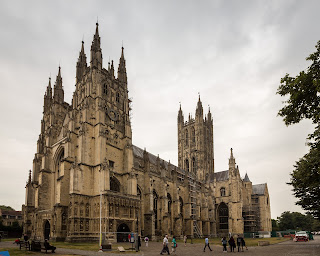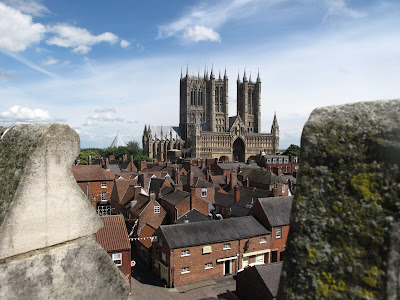A pilfered pipe and the scent of royal roses
'I do not believe there is an atheist in the world who would bulldoze Mecca or Chartres, York Minster or Notre Dame...' - Richard Dawkins
On reaching York Minster, choir member Helen Field, offers some interesting reading:
I passed through York in late summer 2012 as a happy halfway point to meet up with friends travelling up from south. It was a warm, bright day and the stone from the Minster glowed in the sunshine. There was renovation work going on; part of a five-year project which started in 2011. We did not venture inside, sadly. As a result - until now - I had no knowledge of the strong musical tradition around the choir and organ, also of the story behind the unique window dedicated to the memory of women across the British Empire who had lost their lives during the First World War.
According to the York Minster website there have been churches on or near the site where the Minster now stands for nearly 1400 years. The current magnificent cathedral building was constructed over 250 years between 1220 and 1472. It has survived the zeppelins of the First World War, air raids from the Second World War as well as fires in 1753, 1829, 1840 and 1984. It has also played a role in key historical events including the War of the Roses and the Reformation.
York Minster has one of the UK's leading cathedral choirs with choral singing as a tradition going back for over a thousand years. The choir includes both boy and girl choristers. The cathedral was among the first to introduce girl choristers who share the singing equally with the boys. The choir has seven Songmen who are paid, professional singers and five Choral Scholars; paid student singers who gain experience in church music.The recently completed restoration of the Cathedral's Grand Organ, a 'once in a century' three year project, cost £2 million and involved dismantling the organ and taking it to Durham for repair by specialists. The organ dates from the 1830s and has more than 5,400 pipes ranging from the size of a pencil to 33 feet.
Click on the video below to watch a brief BBC piece covering the restoration, including an interview with York Minster's Director of Music and majestical restored sound of the organ itself. The Blessing of the restored Grand Organ was held on Easter Sunday this year.
An earlier BBC report features the return of a stolen organ pipe in 2019 by a German visitor whose companion had removed it as a 'souvenir' of his holiday 50 years previously. Mr Weber, who returned the pipe taken by his friend, recalls, "We said to him 'You can't do it, we are tourists. We should give good behaviour'. (sic) He didn't listen to us and he took this small pipe and put it in his trousers". While it was thought unlikely that the missing pipe would be restored to the organ, Minster staff said that it would be welcomed into the collection of organ pipes.
A further look round the cathedral will take you to admire the Five Sisters Window; rededicated to all the women of the British Empire who lost their lives during the First World War. The window, which originates from the 13th century, was restored and rededicated between 1923 and 1925. It is one of, if not the only, memorial so dedicated. The York Minster webpage explains how the window had been removed during the war to protect it from zeppelin fire. The names of the 1,513 women commemorated are listed on oak screens on the north side of St Nicholas's Chapel. It was further re-dedicated to the women who had died in service in the Second World War but names of those women are not listed on the screens.
One final Cathedral connection of note was the wedding of the Duke of Kent to Katharine Worsley on June 8th 1961. This was the first Royal wedding to have been held at York Minster since the marriage of Edward III in 1328. On the day of the wedding in 1961, the Cathedral was spectacularly filled with masses of sweet-smelling white roses - the symbol of the House of York - and were also included in the bride's bouquet. The event became affectionately known as the 'White Rose Wedding'.
Helen adds that she is much looking forward to returning to York to get acquainted with the Minster in person and thanks her Mum, Eileen, for her vivid recollection of the White Rose Wedding.







Lovely.
ReplyDelete